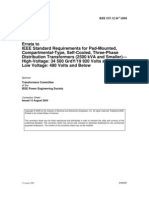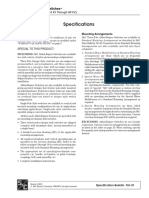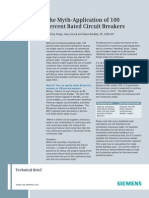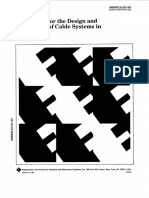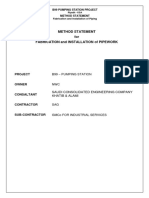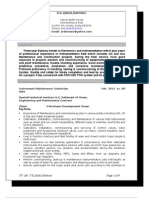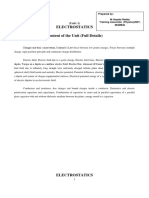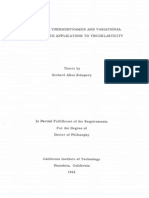Proposed: Soil Resistivity Two-Layer Model, Standard and Standard 81-1983
Proposed: Soil Resistivity Two-Layer Model, Standard and Standard 81-1983
Uploaded by
Carlos Andrés Ruiz HernandezCopyright:
Available Formats
Proposed: Soil Resistivity Two-Layer Model, Standard and Standard 81-1983
Proposed: Soil Resistivity Two-Layer Model, Standard and Standard 81-1983
Uploaded by
Carlos Andrés Ruiz HernandezOriginal Title
Copyright
Available Formats
Share this document
Did you find this document useful?
Is this content inappropriate?
Copyright:
Available Formats
Proposed: Soil Resistivity Two-Layer Model, Standard and Standard 81-1983
Proposed: Soil Resistivity Two-Layer Model, Standard and Standard 81-1983
Uploaded by
Carlos Andrés Ruiz HernandezCopyright:
Available Formats
Soil Resistivity Measurement:
Two-Layer Model, Proposed Revisions to IEEE
Standard 80-2000 and IEEE Standard 81-1983
P Calixto
Author Affiliation: Electrical Department of ABB Lummus
Global B.V., The Netherlands
Abstract: Some simplification to Sunde's procedure, shown in
IEEE Standard 80-2000 13.4.2.2, two-layer soil model by graphical
method is proposed, with the introduction of a modified Sunde's curve.
Comments on Appendix B of IEEE Standard 81-1983 are offered to
correct some formula and improve concepts.
Keywords: Soil resistivity measurement, two-layer model.
Introduction: IEEE Standard 80-2000 offers a graphical method
for determining a two-layer model. Sunde's curves are used, for example, for soil type 1 (Table E2 in Annex E). The Sunde's curve can be replaced by a table (or a graph, if a graphical solution is desired) where
the apparent resistivity is represented by (pa / pl) = (p2 / pl/'m with m
varying from 0.1 to 0.9. This will limit the representation to the range of
useful values of(pa / pl), for the determination of the layer depth h. If a
graphical method is to be used, the ordinate will then be m in uniform
scale versus a/H in logarithmic scale, with parameters (p2 / pl). The table (see Table 1) has the advantage of facilitating interpolation and being more accurate.
The set of pl, p2 and H calculated in this manner can be used for
more sophisticated calculations such as the steepest descent method,
described in IEEE Standard 81-1983, Appendix B. For this, the formulas of Equations B8 have to be corrected.
Modified Sunde's Method: The parameters pl and p2 are obtained
by inspection of resistivity measurements. Only h is obtained by
Sunde's method as follows:
a) Plot a graph of apparent resistivity pa on the y-axis versus pin
spacing on the x-axis.
b) Estimate pl and p2 from the graph plotted in a). The pa corresponding to a smaller spacing is pl and the larger spacing is p2. Extend
the apparent resistivity graph at both ends to obtain these extreme resistivity values if the field data is insufficient.
c) Determine p2 / pl from Table 1 and read the corresponding value
for (a/h), or interpolate them if the ratio (p2 / pl)is not shown. The most
Table 1. Modified Sunde curve
l---T
0.81
m+>p2/pl=
0.001
0.9
5.89
5 3
5 34
-5.10
0.002
0.003
0 005
0.007
0.01
0.02
0.03
0.05
0.07
494
i,
- 4.79
..,
4.50
4.37
4.24
4.17
4.12
4.18
4.32
4.48
4.68
4.87
5.06
0.1
0.2
0.3
0.4
0.5
0.6
07
0.8
0.9
1
1.1
1.2
1.3
1.4
1.5
06
1.7
1.8
1.9
1.04
1.05
1.07
1.12
-.--.-,
1.17
1.23
1.31
1.38
-5
7
10
15
20
30
40
50
60
70
0.98
1.00
1.02
[ 1.04
80
11.05
90
100
120
1.06
1.08
1.10
1.7
1.86
1.98
2.18
. ..
- -1.48
1.56
1.62
1.65
1.71
2.34
1248
1.75
1.79
[1.83
1.90
1.99
2.60
2.71
4.04
4.27
6.36
6.81
11.1
2.81
2.90
2.99
3.14
3.34
4.48
7.22
11.9
4.67
7.61
12.7
7.98
8.66
13.4
150
1.12
170
[1.14
2.04
13.46
200
1.16
2.11
3.63
400
1.25
1.28
300 [ 1.21
2.28
500
600
700
800
900
1000
66
1.30
1.33
1.34
1.36
11.38
2.41
2.52
2.61
400
.48
5.18
5.63
Js5.90
6.27
J 7.30
-8.15
14.07
4.42
2.52-i-14.72
2.69
2.76
2.82
2.88
8.88
4.97
5.20
5.41
9.53
10.1
10.7
5.60
11.6
15.78
_111.6
9.59
14.8
16.7
730.3
110.2
117.9
132.7
11.0
19.6
36.3
28.8
32.7
F56.7
675.5
113.2
47.1j24.5
97.1
15.2
16.9
18.4
19.8
21.2
22.4
23.6
0272-17241021$17.00(02002 IEEE
I-.
36.3
39.6
42.7
45.7
148.6
59.1
64.6
72.5
56
73.8
81.6
89.1
096.4
103
120
141
161
181
200
219
237
306~~~~~~~~~~~~~~~
-7306
368
426
483
540
594
649
IEEE Power Engineering Review, April 2002
Table 2. Method with modified Sunde curves
PI1
p2=
~~~~~~p2pl=
________
A(ft)
6.096A(m)
0.305
3
5
15
20
30
50
70
90
0.914
1.524
100
300
3
displaced
pa/pl=
0.5694
0.8807
0.9548
15.240
21-336
27 432
2076
1.431
1.817
2.0878
2.2775
0.305
0.914
1.524
4.572
6.096
9.144
15.240
21-336
110
33.528
241.48
2.4148
27.432
130
150
39.624
45.720
25177
259.76
2.5177
33.528
39.624
6.096
9.144,
(papp1)
M=
0.305
0.914
1.524
3
5
15
20
4.572
6.096
9 144
30
50
15.240
21-336
27.432
70
90
xi
1.107
1.208
1.208
Y2
2.68787538
p2pl=
0.3
0.4
0.9
4.32
4.48
4.38
0.1
0.79
0.3
1.33
1.31
1.33
0.4
1.62
0.77
0.78
RHO for examnple in IEEE Standard 80-2000 Table E-2
in=
Soil Type 2
pa/pi=
displaced
(pa/p1) m
0
170-14
0.1
-089595846
-05671
0.2
-08782
-0802741562
0.305
263.46
0o9435
0.914
0.3
283.06
-0.719223093
0.2
1.07
1.06
1.07
Y1
xi
-0899
-0825
269.67
247-57
202.12
144.05
9.144
9.144
12
6.096
9.144
9.144
15.240
15.240
15.240
2.5976
0.1
0.2
0.3
0.4
0.5
0.6
0.7
0.8
0.9
300
100
aH= >
-0333333333
aH= >
aH=
120.28
-0.8989
-08252
-0.6737
-04802
-0.4009
110.68
-03689
1.524
4.572
6.096
9.144
15.240
21-336
110
33528
106.41
-03547
27.432
130
39 624
104-34
-0 3478
33.528
>
-0644394015
-0.577350269
-0.517281858
-0.463463057
-0415243647
-0372041058
0.4
0.5
0.6
0.7
0.8
0.9
4.572
6.096
6.096
9.144
9.144
15.240
4.572
6.096
6.096
9.144
21.336
#N/A
#N/A
15.240
#N/A
#N/A
A(m)
X2
1.817
2.088
2.278
2.598
0 33333
3333
p2=
p2pl=
Y1
in=
1.116123174
1.24573094
1.39038917
1L551845574
1.732050808
1.933182045
2.15766928
2.408224685
21-336
27.432
45.720
1.1071
ni=>
A(m)
0.5
0.6
2.25
2.89
Interpolation auxiliary values
04
1.78
6.096
9.144
9.144
15.240
15.240
21-336
27.432
33.528
45.720
p1=
A(ft)
0.3
1.40
0.2
1.07
0.76
aH= >
RHO for example in IEEE Standard 80-2000 Table E-2
Soil Type 1
56.94
88.07
95.48
110.71
1206
143.1
181.7
208.78
227.75
4.572
0.1
M=>
4.70
6.57
8.54
10.88
13.76
17.71
23.47
33.22
1.208
1.431
1.431
1.431
1.431
1 817
1.817
2.088
2.278
2.415
2.598
#DI7T 0!
EPRI
1.60
1.61
0.5
0.6
1.91
1.89
1.90
225_
0.7
3.84
6.116939482
6.102179619
#DIW 0'
206f
(6.096m)
0.8
3.24
0.7
2.66
2.67
2.66
2.24
2.24
Interpolation auxiliary values
X2
A(m)
H(mi)
-0825
4.62
5.916068843
0o674
6.44
6.041850702
-0674
8.02
6.053405618
-0480
9.78
6.068960246
-0480
11.54
6.067665292
-0480
13.62
6.075423804
-0401
16.28
4.244086906
-0825
-0674
-0674
-0674
-0480
#N/A
#N/A
#N/A
#N/A
#N/A
#N/A
0.9
9.09
H(m)
6.204837915
6.124368644
6.10641875
6.109891684
6.104719069
6.128636255
H=
>
0.8
5.44
0.9
4.32
4.48
4.38
3.29
3.26
#N/A
#N/A
H=
EPRI=>
206f
(6.096m)
Table 3. Steepest descent method
IEEE Standard 81 1983 Appendix B
RHO for Example in IEEE Standard 80-2000 Table 8.2
a(m)
0 3048
p
56.94
0.9144
88.07
1.524
95 41
4.572
6.096
9.144
15.24
21 336
27.432
33.528
39.624
110.71
120.76
143.1
181.7
208 78
227.75
241.48
251.77
45.72
259.76
Soil Type 1
0.01
x,o,"y
0.005
0.005
poX(
SpSpI
8pS8p2
SpS8h
57.92
88.79
90 04
109.54
119.47
141.72
181.09
207.40
226.87
241.00
251.63
259.94
1.0002147
1.0005592
0,0002451
1 0012589
0.0010898
1.0139351
1.025761
1.0440078
0.0237252
0.0486734
0.1131851
1.0261829
0.9590563
0.8744943
0.789564
0.2475768
0 3593614
0.4513083
0.5260392
0.7105731
0.5872803
0.6394377
0.6379529
0.0125984
0.0627096
0.0000089
0.1996335
3.0207405
5.5043031
9.662053
12.689283
12.453769
11-560631
10.505809
9.4761023
8.5307172
-0 005
Initial values= =>
AS
Ap
-0289526
Ap2
-256642
-0020512
-0443335
0.47974
-1683824
-003178
-1.702803
0.505137
1.527179
0.5102581
1.5406318
0.5128183
0.5123912
0.5092271
0.5086011
0.5080274
0.507516
0.5070644
1.5454603
1.5424182
1.5334525
1.5327861
1.5323724
1.532085
1.5318703
-0.005
a(m)
0.3048
0.9144
1.524
Ip/8Sp
170.14
263.46
283.06
0.0064872
-0000245
-0.053456
-0 343312
0 9999903
0.0000123
263-19
283.06
0.9990747
0.9947847
0.0011531
p2
516.64922
338.18418
-0034323
-0035063
95.110412
101.51455
31378357
303-12498
-0034243
-0033333
-0032699
-0 032782
-0032861
-0032987
-0033122
-0033252
102.53825
306.26018
103.0603
307.91628
308.08418
103.05137
102.50399
102.45943
102.41412
102-37173
102-3335
306.6775
306.79194
306.88884
306.97092
307-04063
h
4.0086689
6.189248
006794735
6.8298843
6.6897576
6.5363374
6.4366989
6.4637889
6.4862106
6.5162235
6.5471494
6.576511
-0009976
-0.00734
-0.005739
-0.009327
-0008771
-000751
-0003334
-0.008358
-0005862
-0003409
-0001068
0.0014192
Soil Type 2
-0005
0 005
Sp/Sp2
171 12
300
57.615378
88.221776
RHO for Example in IEEE Standard 80-2000 Table E-2
0.01
100
-0.855611
-1316738
-1.419676
initial values=
Ap2
-0.284753
-0435512
-0.46911
300
100
57.50504
0 0358056
170.26658
262.02725
282.49424
p2
0.0586229
0.0385639
87-939328
94.697161
12.074289
7.9412581
7.3699854
-0.009868
0.0026649
0.0000164
0.0007613
-0.007667
41572
260.67
269061
0.8814601
0.14640
-6856415
1,451418
-0470256
0.0341303
288 47001
96.474615
60904642
6.096
9.144
247-57
-11.4653
-16.55398
-13.94835
-9.082716
0.0337692
0.0337416
0.0353098
0.0355166
92.951122
-1377657
-1427199
279.45714=
92.750073
6.9022641
6.8641056
7.136936
7.1456353
27.432
110.68
111.34
0.0365977
1.0436481
5 .404728
-1.483501
-0474934
-0463965
-0451184
-0.465594
-0.482589
285.6643
278-93035
271.00264
21-336
0.2811817
0.5604483
0.8886303
1.014555
95.438262
144.05
120.28
0.7707824
0.535353
0.2356138
0.0933919
-1439753
-1410243
15.24
248.15
202-53
144.64
120-89
0.0351272
289.59204
96.048244
7.0464104
-0.008861
33.528
106.41
109.19
-3.320728
-0.520687
-0.116225
103.76
0.0050375
-0.025087
-151971 j
-1.445282
299.97491
297.04144
298.54688
6.8837745
6.9949353
6.9839328
-0.008196
104.94
.0413746
99.479313
104.34
103.16
0.0167244
0.0084651
39.624
45.72
202.12
IEEE Power Engineering Review,
April 2002
1.0340634
1.0269131
-2.077845
-1.417293
0.495052
-0.497361
0.0349242
0.034254
90.05903
98.490626
98.989109
-0006336
-0009956
-0009394
-0.006921
-0.006585
67
important values of a/h is m = 0.5, which corresponds to the inflexion of
Sunde's curve, i.e., values most sensitive to h.
d) From the graph in a) read the probe spacing a corresponding to pa
= (pl * p2), i.e., the geometric mean of pl and p2.
e) Divide the probe spacing a by a/h found in c; this will be depth of
the upper layer h.
Using the soil data from soil type 1 in Table E.2 of Appendix E, a
plot of resistivity versus spacing can be drawn. See Figure 22 of the
Standard. Both p 1 and p2 can be determined by visual inspection. Assuming pl = 1002.m and p2 = 300Q.m, the following example illustrates the modified Sunde's graphical method:
a) Plot Figure 22.
b) Choose pl = 100l.m and p2 = 300Q2.m.
c) p2/pl=300/100 = 3. Read in Table 1 the corresponding value for
m = 0.5, a/h = 2.25.
d) Read the probe spacing corresponding to (100
+*300) = 173
Q.m, h = 13.8 m.
e) The depth of upper layer is 13.8/2.25 = 6.13 m or 20.1 ft.
This compares favorably with the 6.1 m (20 ft.) using EPRI TR-100622
[B63].
Extended Calculation with Modified Sunde's Method: Instead
of using only m = 0.5 in Table 1, it is possible to use all values from 0.1
up to 0.9. The result will give a more thorough examination of the measured resistivity to locate possible irregularities. Table 2 exemplifies the
application of this method via spreadsheet, the graphic was replaced by
logarithmic interpolation, i.e., y = yl *(y2/yl)A(ln(x/xl)/ln(x2/xl)). The
soil 2 is shown as well.
Steepest Descent Method: This method is described by IEEE Standard 81-1983, Appendix B. All three parameters pl, p2, and h can be
calculated, starting with assumed initial values that can be obtained as
described above. Table 3 shows the results of this method for soils type
1 and 2.
The following comments apply:
Equations (1) and (2) should be used for only one average value of
apparent resistivity (N = 1). The equations imply harmonic mean of the
measured values. It is more common practice to use arithmetic or geometric mean (harmonic mean is the smallest of all three). The decision
on what average to be used is left then to the engineer.
The convergence factors (t, y, and y ) should be more clearly defined; presently they are implied to be 0.005/(68/6p).
We need to obtain the (6P/6p) value for the next iteration, based on
its value on the previous iteration. The expression for the derivatives
(Eq. B8) should be corrected as follows:
For 6p / 5p2 the term (1I-KA2) should read (1-K)A2.
For 5p / h the term in the summation (KAn) should read (nA2*KAn).
The signs of(t, r, and y) should be reversed sometimes to reach convergence, minus to decrease the initial value and plus to increase it.
References:
[ 1 ] IEEE Guide for Safety in AC Substation Grounding, IEEE Standard 80-2000, 2000.
[2] IEEE Guide for Measuring Earth Resistivity, Ground Impedance and Earth Surface Potentials of a Ground System, IEEE Standard
81-1983, 1983.
Copyright Statement: ISSN 0282-1724/02/$17.00 ( 2002 IEEE.
Manuscript received 12 August 2001. This paper is published herein in
its entirety.
Ww =. _
A New Method for Determining Reference
Compensating Currents of Three-Phase
Shunt Active Power Filters
Gary W Chang
Author Affiliation: Department of Electrical Engineering, National Chung Cheng University, Taiwan.
Abstract: Using a shunt active power filter (SAPF) has been proved
as an effective method to compensate reactive power and to mitigate
harmonic currents of nonlinear loads. When designing a SAPF, it is
crucial to generate reference currents for determining actual compensating current injections to the point of common coupling. In contrast to
the conventional instantaneous reactive power theory, which needs coordinate transformations, the new method proposed in this letter is to
determine reference compensating currents based on the balance of the
instantaneous reactive and active power generated in the SAPF. It is
shown that the proposed method is suitable for reactive and harmonic
power compensation by using a SAPF. In addition, to maintain the sinusoidal source currents this method also eliminates the need for installing energy storage devices for reactive power compensation as well as
the dc source for the harmonic compensation in the active power filter.
Therefore, a simpler design of the SAPF with minimal line losses can
be expected.
Keywords: Active power filter, reference compensating current, instantaneous reactive power theory, coordinate transformation, instantaneous power balance.
Introduction: The concept of using the SAPF for reactive and harmonic power compensation was introduced more than two decades
ago. By measuring load currents and voltages, the SAPF can inject
compensating currents as well as absorb or generate reactive power at
the point of common coupling for controlling harmonics and compensating reactive power of the connected load.
In 1983, Akagi et al. proposed an innovative approach based on instantaneous reactive power theory (i.e., p - q theory) to compute SAPF
reference compensating currents. This approach inspired the development of many other p - q theory-based methods for realizing the SAPF
[I],[2]. Willems indicated that the p - q theory is complete only in
three-phase systems without zero-sequence component, however [3].
Also, the instantaneous reactive power theory-based method requires
coordinate transformations between the a - b - c coordinates and the
p - q coordinates, which increases the complexity of designing the
SAPF controller. More recently, Peng et al. proposed a theory that gave
a generalized definition of the instantaneous reactive power in the
a - b - c coordinate [4]. Although Peng's approach does not need the
coordinate transformation, it requires an additional function for instantaneous reactive power vector calculation in the SAPF controller.
Based on the instantaneous reactive power space vector defined in [4]
PES Web Site
http.//www.ieee.org/power
The PES Web site (http://www.ieee.org/power) contains
current information on PES Meetings, Chapters, and Technical Activities. The home page contains links to the following items to which we call your attention:
* 2002 PES Organization Manual & Committee Directory
* PES Author's Kit and Presentation Guidelines.
Figure 1. Schematic diagram of the three-phase SAPF compensation
68
0272-17241021$17.00(02002 IEEE
IEEE Power Engineering Review, April 2002
You might also like
- BoF Insights - Gen-Z and Fashion in The Age of RealismDocument99 pagesBoF Insights - Gen-Z and Fashion in The Age of Realismcamila.naraymoyahm.comNo ratings yet
- Construction Project Management Planning, Scheduling and Controlling K.K ChitkaraDocument290 pagesConstruction Project Management Planning, Scheduling and Controlling K.K ChitkaraAref Malkawi88% (17)
- Epson DS 7000 Service ManualDocument2 pagesEpson DS 7000 Service Manualchrisban350% (3)
- The Technology of Instrument Transformers: Current and Voltage Measurement and Insulation SystemsFrom EverandThe Technology of Instrument Transformers: Current and Voltage Measurement and Insulation SystemsNo ratings yet
- IEEE C57.91-1981-Transformer Loading PDFDocument65 pagesIEEE C57.91-1981-Transformer Loading PDFAvijnan Mitra50% (2)
- Ab60F Automatic Transmission: DescriptionDocument2 pagesAb60F Automatic Transmission: Descriptionautomaticosbrasil0% (2)
- Active Harmonic Filters Are Mostly Used For Low-Voltage NetworksDocument25 pagesActive Harmonic Filters Are Mostly Used For Low-Voltage NetworksAlok PatelNo ratings yet
- C57 (1) .12.34-2004 ErrataDocument2 pagesC57 (1) .12.34-2004 Erratamagdy522100% (1)
- ANSI/IEEE C37.010e-1985: Approved September 18, 1980Document2 pagesANSI/IEEE C37.010e-1985: Approved September 18, 1980أمين توات الجزائريNo ratings yet
- IEEE Standard For Interrupter Switches For Alternating Current, Rated Above 1000 VoltsDocument66 pagesIEEE Standard For Interrupter Switches For Alternating Current, Rated Above 1000 VoltsVICTOR JOSE VILORIANo ratings yet
- Ansi Ieee C37 010 1979 PDFDocument54 pagesAnsi Ieee C37 010 1979 PDFFelipe Fonseca100% (2)
- IEEE STD ANSI-IEEE STD C37.23-1987Document38 pagesIEEE STD ANSI-IEEE STD C37.23-1987abdou sami100% (2)
- IEEE Guide To The Assembly and Erection of Metal Transmission StructuresDocument44 pagesIEEE Guide To The Assembly and Erection of Metal Transmission StructuresGenesis ToledoNo ratings yet
- Ieee C57.19.100-2012 10.1109@ieeestd.2013.6469143Document42 pagesIeee C57.19.100-2012 10.1109@ieeestd.2013.6469143Rayhan KhanNo ratings yet
- Nema TP1-2002 PDFDocument16 pagesNema TP1-2002 PDFwarwarkingNo ratings yet
- Auto-Transformer Design - A Practical Handbook for Manufacturers, Contractors and WiremenFrom EverandAuto-Transformer Design - A Practical Handbook for Manufacturers, Contractors and WiremenRating: 4 out of 5 stars4/5 (2)
- Shim Alvin 1770934 Tues 430Document17 pagesShim Alvin 1770934 Tues 430shimmyNo ratings yet
- IGC Code Changes PDFDocument3 pagesIGC Code Changes PDFswarg vibha100% (1)
- Coating Systems For The Series Version of Standard Trucks As Well As For Bus Components and AttachmentsDocument24 pagesCoating Systems For The Series Version of Standard Trucks As Well As For Bus Components and AttachmentsAkmal NizametdinovNo ratings yet
- Ansi C37.06.1-2000Document12 pagesAnsi C37.06.1-2000moralesmjyNo ratings yet
- Guide For Transformer Impulse Tests: Ansi/Ieee C57.98-1986Document42 pagesGuide For Transformer Impulse Tests: Ansi/Ieee C57.98-1986Júlio Nunes100% (1)
- IEEE Standard Electrical, Dimensional, and Related Requirements For Outdoor Apparatus BushingsDocument18 pagesIEEE Standard Electrical, Dimensional, and Related Requirements For Outdoor Apparatus Bushingsketo diet eaterNo ratings yet
- IEC 71-2 (1996) Air ClearanceDocument2 pagesIEC 71-2 (1996) Air ClearanceBasim Al-Attar100% (1)
- Ansi-Ieee C37.012-1979Document61 pagesAnsi-Ieee C37.012-1979Juan Manuel100% (1)
- Parameter Estimation For Induction Machines Based On Sensitivity AnalysisDocument6 pagesParameter Estimation For Induction Machines Based On Sensitivity AnalysisRoberto SuNo ratings yet
- S13-C57.12.90 Section 9.5 Zero Seq With ModsDocument5 pagesS13-C57.12.90 Section 9.5 Zero Seq With ModsshubhamNo ratings yet
- Ieee STD Ansi-Ieee c37.12-1979Document54 pagesIeee STD Ansi-Ieee c37.12-1979abdou sami100% (1)
- NESC 07 12 ChangesDocument31 pagesNESC 07 12 ChangesTim Mit100% (1)
- 1377 1997Document201 pages1377 1997Ann DodsonNo ratings yet
- Disadvantages of Wye-Wye TransformerDocument1 pageDisadvantages of Wye-Wye TransformerErwin C. DirectoNo ratings yet
- C57 12 58-1991 PDFDocument22 pagesC57 12 58-1991 PDFEdwin CapdepomtNo ratings yet
- Ansi-Ieee C37.29-1981Document18 pagesAnsi-Ieee C37.29-1981mercenariotkd0% (1)
- Edoc 001864Document52 pagesEdoc 001864leesger7No ratings yet
- Dawalibi Earth Resistivity PDFDocument9 pagesDawalibi Earth Resistivity PDFRaul Marihuan GonzálezNo ratings yet
- IEEE STD C57.12.01-1989Document26 pagesIEEE STD C57.12.01-1989Júlio NunesNo ratings yet
- Motor ProtectionDocument58 pagesMotor ProtectionVenkat Subramanyam.CNo ratings yet
- 112-1996 Ieee StandardDocument2 pages112-1996 Ieee StandardRicardo Lisboa0% (1)
- 100 Percent Vs 80 Percent Breaker MythDocument4 pages100 Percent Vs 80 Percent Breaker Mythcow221100% (1)
- Arrester-Discharge-Counter-Tester 3KVDocument6 pagesArrester-Discharge-Counter-Tester 3KVrioNo ratings yet
- Norma IEEE C37 PDFDocument13 pagesNorma IEEE C37 PDFEddie Marin100% (1)
- Comparación Entre IEC 76 y ANSI C57-12Document5 pagesComparación Entre IEC 76 y ANSI C57-12César Díaz LiberonaNo ratings yet
- IEEE STD C37.20.2b-1994 Suplemento PDFDocument3 pagesIEEE STD C37.20.2b-1994 Suplemento PDFDaniel Gonzalez LucianiNo ratings yet
- 04504772-Standardization of Benchmarks For Protective Device Time-Current CurvesDocument11 pages04504772-Standardization of Benchmarks For Protective Device Time-Current CurvesDar Win100% (1)
- ANSI C57.12.24-2000 Underground-Type Three-Phase Distribution Transformers, 2500 kVA and Smaller HighDocument18 pagesANSI C57.12.24-2000 Underground-Type Three-Phase Distribution Transformers, 2500 kVA and Smaller HighJesus RuizNo ratings yet
- T-08 LTC Dga Guide AscheDocument7 pagesT-08 LTC Dga Guide Aschebcqbao100% (1)
- Table A45 Z IMpedancias de SistemaDocument1 pageTable A45 Z IMpedancias de SistemaFersh Valderramash100% (1)
- Understanding The Arrester DatasheetDocument9 pagesUnderstanding The Arrester DatasheetEvglazNo ratings yet
- ANSI IEEE C37.5-1979 Guide For Calculation of Fault Currents For Application of Ac High-Voltage Circuit Breakers Rated On A Total Current BasisDocument23 pagesANSI IEEE C37.5-1979 Guide For Calculation of Fault Currents For Application of Ac High-Voltage Circuit Breakers Rated On A Total Current Basisruben100% (4)
- IEC61000 4 5 2014 StandardDocument79 pagesIEC61000 4 5 2014 StandardAswin Lorenso Gultom NamoralotungNo ratings yet
- Pesgm2009 000212Document8 pagesPesgm2009 000212julianvillajosNo ratings yet
- Capacitor Bank SwitchingDocument52 pagesCapacitor Bank Switchingmv1970No ratings yet
- IEEE Colour BooksDocument2 pagesIEEE Colour BooksarunmozhiNo ratings yet
- IEEE STD ANSI-IEEE STD 525-1987Document39 pagesIEEE STD ANSI-IEEE STD 525-1987abdou samiNo ratings yet
- Iec60076 11 I1 (Ed2.0) enDocument2 pagesIec60076 11 I1 (Ed2.0) enRyanNo ratings yet
- Motor Thermal Limit CurveDocument6 pagesMotor Thermal Limit CurveJasjit SinghNo ratings yet
- TRYSTAR Electrical Panel CatalogDocument11 pagesTRYSTAR Electrical Panel CatalogFederico Pérez de LeónNo ratings yet
- C57.12.59-2001 Errata PDFDocument2 pagesC57.12.59-2001 Errata PDFJose Perez PerezNo ratings yet
- Comparison of The Response of Doubly Fed and Fixed-Speed Induction Generator Wind Turbines To Changes in Network FrequencyDocument3 pagesComparison of The Response of Doubly Fed and Fixed-Speed Induction Generator Wind Turbines To Changes in Network Frequencyalaaa3No ratings yet
- ANSI Standard Burden Sets-C57.13-1978.Document3 pagesANSI Standard Burden Sets-C57.13-1978.srinivasaphanikiranNo ratings yet
- Air Core ReactorDocument4 pagesAir Core ReactorBilal AhmadNo ratings yet
- IEEE 485 Lead Acid Batteries For Stationary Applications: Calculation of Battery SizeDocument3 pagesIEEE 485 Lead Acid Batteries For Stationary Applications: Calculation of Battery Sizehicham boutoucheNo ratings yet
- Transformer Magnetizing Inrush Currents: For Most Transformers, It Is A Good Approximation ToDocument1 pageTransformer Magnetizing Inrush Currents: For Most Transformers, It Is A Good Approximation ToZnevba QuintanoNo ratings yet
- C37.90.3-2001 IEEE Standard Electrostatic Discharge Tests For Protective RelaysDocument20 pagesC37.90.3-2001 IEEE Standard Electrostatic Discharge Tests For Protective RelaysAnonymous OCVSDEleNo ratings yet
- Guide For Ac Motor Protection: ANSI/IEEE C37.96-1988Document70 pagesGuide For Ac Motor Protection: ANSI/IEEE C37.96-1988nokdiegoNo ratings yet
- C57 109-1985Document10 pagesC57 109-1985mjimenezg100% (1)
- Physics: University of Cambridge International Examinations International General Certificate of Secondary EducationDocument8 pagesPhysics: University of Cambridge International Examinations International General Certificate of Secondary EducationSam FordNo ratings yet
- FINAL Chapter 6 Conical Dryer 1Document16 pagesFINAL Chapter 6 Conical Dryer 1Milton Dels RosaNo ratings yet
- Thesis Educational Management PhilippinesDocument8 pagesThesis Educational Management Philippinesczbsbgxff100% (2)
- Lecture 1Document5 pagesLecture 1ahmadyonis55tNo ratings yet
- TRIATOX Fraccionamiento de Aceite de PalmaDocument61 pagesTRIATOX Fraccionamiento de Aceite de PalmaFernando ValerianoNo ratings yet
- The Effect of Nature Documentaries On STDocument10 pagesThe Effect of Nature Documentaries On STu2104948No ratings yet
- CSR in Malaysian CEO StatementsDocument4 pagesCSR in Malaysian CEO StatementsnureeNo ratings yet
- Method Statement For Piping Works - B99 Pump StationDocument14 pagesMethod Statement For Piping Works - B99 Pump StationMohamed100% (1)
- Imaging and Design For Social ImpactDocument13 pagesImaging and Design For Social ImpactKristian AddisonNo ratings yet
- Abdul Rahman ResumeDocument4 pagesAbdul Rahman ResumeArun SasiNo ratings yet
- Notes and Handouts - ElectrostaticsDocument51 pagesNotes and Handouts - ElectrostaticsNandanaNo ratings yet
- Titanic PowerpointDocument30 pagesTitanic Powerpointthethingsyoucanread100% (1)
- Variable Speed Pump PDFDocument73 pagesVariable Speed Pump PDFSenghy MaoNo ratings yet
- Smaw 12 Module 1 Grade 12Document39 pagesSmaw 12 Module 1 Grade 12Francis Rico Mutia Rufon100% (15)
- AAD Prac 7.1 To 10 SPDocument24 pagesAAD Prac 7.1 To 10 SPshaktisinghdr7060No ratings yet
- Case 14Document19 pagesCase 14DươngNo ratings yet
- Computer Organization Lab 17012013Document22 pagesComputer Organization Lab 17012013R K S B O TNo ratings yet
- MB m.2 Support Am4Document2 pagesMB m.2 Support Am4HhhhCaliNo ratings yet
- Corrosion in Petroleum IndustryDocument12 pagesCorrosion in Petroleum IndustryAnurag Borah0% (1)
- Circular Slide Rule PDFDocument2 pagesCircular Slide Rule PDFJosé Antônio CardosoNo ratings yet
- Schapery RA 1962 (PHD Dissertation)Document182 pagesSchapery RA 1962 (PHD Dissertation)Marcelo MedeirosNo ratings yet
- FQ, FTQ, Data Sheet 4921210047 UK PDFDocument3 pagesFQ, FTQ, Data Sheet 4921210047 UK PDFAlexNo ratings yet
- Expanplast SRDocument3 pagesExpanplast SRAmar Wadood KhanNo ratings yet
- Exercise 6B - Mode - Report - Unit 3 - People - 3.1 - Listening - IB3-B2 - 3 - MyEnglishLabDocument1 pageExercise 6B - Mode - Report - Unit 3 - People - 3.1 - Listening - IB3-B2 - 3 - MyEnglishLabGlenddaQuispePeñaNo ratings yet
- Is 3485 1983Document8 pagesIs 3485 1983sureshNo ratings yet







